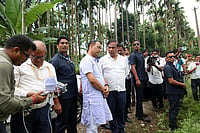To improve the production of litchi in Bihar, the state government and National Research Centre on Litchi (NRCL) are encouraging growers to produce newly developed varieties of the fruit by addressing issues like “productivity gap” and post-harvest management.
Bihar produces 43 per cent of litchi in the country and occupies nearly 35 per cent of the area under cultivation of the fruit in India, state Agriculture Minister Kumar Sarvjeet said.
“Currently, the Bihar government and NRCL (Muzaffarpur) are taking joint initiatives to improve litchi production, its quality and shelf-life. Apart from increasing the production of GI-tagged Shahi Litchi, farmers are also being encouraged to produce newly developed varieties of the fruit”, the minister told PTI.
Efforts are on to grow three new litchi varieties -'Gandaki Yogita', 'Gandaki Sampada', 'Gandaki Lalima'- in the eastern state. The Shahi Litchi, a speciality of the north Bihar district of Muzaffarpur, which earned the Geographical Indication (GI) tag a couple of years ago, stands apart from other varieties by virtue of its unique fragrance, extra-juicy pulp, and smaller-than-usual seed.
India is the second largest producer of litchi in the world, after China. Talking to PTI, Bikash Das, Director, ICAR-NRCL (Muzaffarpur), said, “The contribution of Muzaffarpur district in litchi production is impressive, but there is a need to increase the productivity of litchi.
“The ICAR-NRCL has the mandate to address the productivity gap through basic and strategic research in areas of crop improvement and genetic enhancement, development of sustainable production technologies, integrated pest management systems, and post-harvest management and value addition”.
Since litchi is a non-climacteric fruit that possesses poor shelf life, the post-harvest losses have been assessed to the tune of 18-23 per cent, the official said. “It is another challenge to reduce the losses with suitable post-harvest management tools”, the official said.
Apart from helping farmers to adopt new methodologies to improve the production of Shahi Litchi, the NRCL is also encouraging them to produce newly discovered varieties of litchi, including 'Gandaki Yogita', 'Gandaki Sampada' and 'Gandaki Lalima', Das said.
'Gandaki Sampada', a high-yielding and high pulp containing variety of litchi, developed by ICAR-NRCL, is a late-maturing clone that ripens during mid-June, the official said. "The Gandaki Sampada litchi variety is large (35-42g), and conical in shape. The pulp is creamy-white, soft, and juicy with a pleasant aroma. The variety has good yield potential (120-140 kg/tree)”, said the director.
Similarly, 'Gandaki Yogita', is a slow-growing dwarf plant that is tolerant to heat waves. “It has good yield potential (70-80 kg/tree) and its maturity period is from June 5 to June 15. “As far as Gandaki Lalima variety of litchi is concerned, the fruits are conical, bright marigold-orange red in colour. The average yield of this variety is 130-140 kg/tree”, said Das.
According to Bihar Economic Survey (2022-23), the production of litchi in the state was 308.1 metric tonnes in 2021-22, whereas it was 308 metric tonnes in 2020-21. Shahi Litchi got the GI tag, thereby becoming an “exclusive brand” in national and international markets, in 2018.
Muzaffarpur, Vaishali, Samastipur, Champaran, Begusarai districts, and adjoining areas of Bihar have a favourable climate for this variety. The Department of Posts recently issued a postage stamp on Shahi Litchi of Muzaffarpur.


























